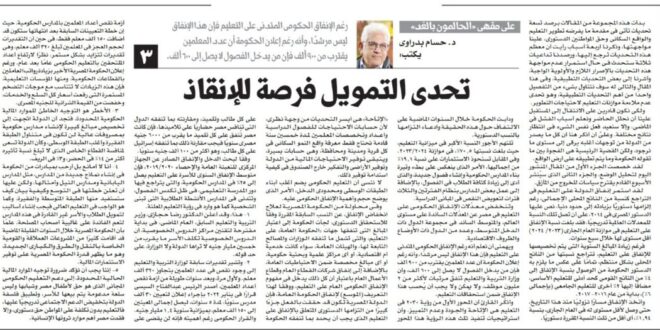The opportunity to rescue (3)
The challenge of funding
This group of articles began by monitoring nine challenges that come at the forefront of what the development of education, the population reality, and the constitutional right of citizens impose on us to confront them. We mentioned four reasons that I saw that most of these challenges are due to them, and we monitored three repercussions that will occur in the event that these challenges continue to be not confronted with the necessary insistence and due priority, and we pointed out some practical challenges. In this article and the one following it, we will address in some detail one of the most important practical challenges, which is the challenge of the inadequacy of education budgets to development needs.
In order to be able to move to the future, we must analyze the present and know the reasons for failure in the past, otherwise we will repeat the same thing while waiting for different results, which is Einstein’s definition of stupidity.
I must mention here that most of the directions issued by the state rise to the level of what we hope for, but the main issue is the gap between what the government says and what is implemented on the ground. The first part of today’s article is devoted to an analysis of the situation, and the second part, which will be published next week, proposes policies to get out of the impasse.
State spending on education has continued to decline as a percentage of GDP, despite the constitutional obligation to increase it to a minimum, stipulated by the Egyptian Constitution in 2014, so that this percentage will gradually reach global rates. The percentage of spending on education in the current year’s budget (2023/2024) has reached its lowest level in seven years.
Despite the increase in the annual amounts allocated to spending on education, its percentage of GDP has been declining regularly, completely contrary to what the constitution requires the government to achieve a spending percentage of 4% of the national product as a minimum for basic education, in addition to another 2% for university education (totaling 6%), starting from 2016-2017.
Spending has been on a downward path since that date, until it reached its lowest level this year, at 1.94%, less than a third of the constitutionally mandated percentage.
The government has been keen over the years The past has tried to circumvent this fact and claim its commitment to constitutional proportions, but the President of the Republic admitted for the first time last June that the government does not adhere to the constitutional minimum for public spending on both education and health. Wages consume the largest proportion of the education budget, reaching 70.5% in the 2023/2024 budget. In contrast, investments account for 19.1% of the total, which is reflected in the slow pace of building government schools and creating new classrooms, which has led to an increase in the density of students in classrooms, in addition to some schools operating in two and three shifts to compensate for the shortage in school buildings. Government spending rates on education in Egypt are lower than the rates prevailing worldwide, and the average prevailing in the group of countries with Middle income, and a number of countries with economic conditions and circumstances that can be compared to the Egyptian economy. I would like to know that despite the low government spending on education, this spending is not rational, and that despite the government’s announcement that the number of teachers is approaching 900,000, those who enter the classrooms do not reach 600,000, and that the Ministry of Education spends salaries for more than 2 million employees, and this spending cannot and should not be counted as part of education entitlements. .
I remind the reader that the first axis of Vision 2030 in education is availability, quality and non-discrimination, and that the strategies for implementing a third of this vision, this axis “availability”, are the easiest challenges from my point of view because calculating the needs for classrooms and the numbers and specializations of teachers for the next fifty years only requires knowing the reality of population growth in each village, city and governorate, and these are easy calculations. What remains is providing the financial needs from the state, providing land and thinking outside the box about how to sustain providing this.
Let’s not forget that government education includes most of the children of the middle classes and those with limited income, which clarifies the size and importance of government spending on it. In an attempt by the Egyptian government to address the decrease in spending, from the previous percentages determined according to the constitutional entitlement, the government resorted to considering the amounts spent by the “general government” entities on education, which includes what is spent by ministries and their affiliated departments, public bodies, whether service or economic, or any government scientific and research centers, or any amounts allocated within the general reserves, in addition to the spending of companies The public sector and the public business sector, considering that all of this falls within the concept of general government spending on education, and according to this (expanded) definition of general government spending, the Egyptian state has already achieved a large part of its constitutional commitment related to spending on education, which must be determined by what the government spends on each student and pupil and compared to what countries that compete with Egypt in civilization spend on their pupils. If Egypt spends approximately 6,000 Egyptian pounds per year on each pupil, this must be compared to what Israel spends on each student, which is more than 100,000 pounds per year. What is terrifying is that part of Egypt’s foreign debts will be paid By deducting from the education budget, the state resorts to fulfilling its constitutional obligation by considering the payment of the equivalent of 15% of the value of debt repayment to education allocations.
According to the income and expenditure survey issued by the Central Agency for Public Mobilization and Statistics 2019/2020, the average annual family spending on education reaches 25% in public schools, where the educational role of the school is declining, in light of overcrowding of classrooms and the decline in student activities in schools that build character, as stated in the announced education vision. 1. Dr. Reda Hegazy, the former Minister of Education, announced last year, at the beginning of his proposal to regulate private tutoring centers, that private tutoring costs families approximately fifty billion pounds, which neither the state nor the ministry sees, according to what he said. 2. Previous estimates by the Ministry of Education indicate a shortage in the number of teachers exceeding 320,000 teachers. For the first time and after many years of a teacher shortage crisis, President Abdel Fattah El-Sisi issued a decision in January 2022 to announce the appointment of 30,000 teachers annually for a period of 5 years, bringing the total number of appointees to 150,000 teachers, with an annual budget of 1.4 billion pounds. Despite its importance, the government decision will not eliminate On the crisis of the shortage of teachers in government schools, as the previous appointment plan, after its completion, will have added only 150 thousand teachers, while estimates of the size of the teacher deficit amount to 320 thousand teachers, and these estimates are constantly increasing, due to the increase in the number of those enrolled in government education year after year. Despite the recent announcement by the Egyptian government to increase the salaries of workers in government sectors, including educational institutions, These increases are not commensurate with the ongoing waves of inflation that have raised the prices of all goods and services, and reduced the purchasing value of the Egyptian pound. 3. The most dangerous thing is the misdirection of limited government financial resources: We find that the state has moved towards allocating large sums to establish government schools with high expenses that will not be within the reach of the poor class and most of the middle class, as if the state is seeking to compete with the private sector, whose influence does not exceed 14% in urban areas and 3% in rural areas. 4. I do not mind, but rather welcome, government initiatives to establish new models of schools such as Japanese schools, Nile schools, and the like, but it must announce its expansion plan and how to show how the middle and poor classes will benefit from it. As is the duty in higher education, methods must be created to finance students and families who are unable to afford these schools so that the benefit is spread to the majority of stakeholders, knowing that the Egyptian government has established many giant and national projects in the past few years related to transportation, roads, and new bridges, which shows the Egyptian government’s ability to provide financial investments. 5. We must emphasize the necessity of directing the current limited financial resources to support free public education, which is a right for Egypt’s children and youth, and not a subsidized commodity sold to families, and to apply the state’s philosophy of gradually reducing social support to it, as education without cost to the citizen is a constitutional right, otherwise Egypt will lose the most important resource of its human wealth.
 Dr. Hossam Badrawi Official Website
Dr. Hossam Badrawi Official Website


